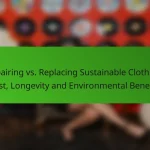Sustainable fashion is increasingly shaped by worker cooperatives, which prioritize fair labor practices and environmental responsibility. By empowering workers and promoting ethical production, these cooperatives set a precedent for a more equitable and sustainable industry. Successful case studies highlight the positive impact of collective ownership on both labor conditions and environmental sustainability, encouraging consumers to make intentional choices that support this movement.

How do worker cooperatives impact sustainable fashion?
Worker cooperatives significantly influence sustainable fashion by prioritizing fair labor practices and environmental responsibility. These organizations empower workers, reduce exploitation, and promote ethical practices, creating a more sustainable industry overall.
Empowerment of workers
Worker cooperatives empower individuals by giving them a voice in decision-making processes. This structure allows members to share profits and responsibilities, fostering a sense of ownership and commitment to their work.
In a cooperative model, workers often receive training and development opportunities, enhancing their skills and career prospects. This investment in human capital not only benefits the workers but also contributes to the overall quality and sustainability of the fashion products they create.
Reduction of exploitation
Worker cooperatives help reduce exploitation by ensuring fair wages and safe working conditions. Unlike traditional fashion companies, cooperatives prioritize the well-being of their members, which leads to more equitable labor practices.
By eliminating profit-driven motives that often lead to worker mistreatment, cooperatives can create a more just supply chain. This shift not only benefits workers but also appeals to consumers increasingly concerned about ethical sourcing in their fashion choices.
Promotion of ethical practices
Worker cooperatives promote ethical practices by adhering to sustainable production methods and prioritizing environmental stewardship. Many cooperatives focus on using eco-friendly materials and minimizing waste, aligning their operations with sustainable fashion principles.
Additionally, cooperatives often engage in transparent supply chains, allowing consumers to trace the origins of their products. This transparency builds trust and encourages more responsible consumption, further enhancing the impact of sustainable fashion initiatives.

What are successful examples of worker cooperatives in sustainable fashion?
Successful examples of worker cooperatives in sustainable fashion demonstrate how collective ownership can lead to ethical production practices and fair labor conditions. These cooperatives prioritize environmental sustainability and social equity, creating a positive impact on both workers and the planet.
Cooperative Fashion Collective
The Cooperative Fashion Collective is a network of fashion workers who operate under a cooperative model, emphasizing sustainable practices and fair wages. Members collaborate to design and produce clothing that meets ethical standards, often using eco-friendly materials.
This collective encourages transparency in the supply chain, allowing consumers to understand the origins of their garments. By pooling resources, members can reduce costs and improve access to sustainable materials, making it easier to compete with conventional fashion brands.
Union of Concerned Scientists
The Union of Concerned Scientists (UCS) advocates for sustainable practices in various industries, including fashion. While not a cooperative itself, UCS collaborates with worker cooperatives to promote environmentally friendly practices and labor rights within the fashion sector.
UCS emphasizes the importance of scientific research in guiding sustainable fashion initiatives. Their partnerships with cooperatives help ensure that production methods are not only ethical but also scientifically sound, supporting both workers and the environment.
Workers’ Rights Consortium
The Workers’ Rights Consortium (WRC) is an independent labor rights organization that monitors and promotes fair labor practices in the apparel industry. They work closely with worker cooperatives to ensure compliance with labor standards and advocate for the rights of garment workers.
By conducting investigations and providing resources, the WRC helps cooperatives implement best practices in labor rights and sustainability. Their efforts contribute to a more equitable fashion industry, where workers have a voice and are treated with dignity and respect.

How can consumers support sustainable fashion cooperatives?
Consumers can support sustainable fashion cooperatives by making intentional purchasing decisions, advocating for fair labor practices, and engaging with their local communities. These actions not only promote ethical fashion but also empower workers and foster a more sustainable industry.
Purchasing from cooperatives
Buying directly from worker cooperatives ensures that profits are shared among the workers, enhancing their economic stability. Look for cooperatives that prioritize sustainable materials and ethical production methods. Many cooperatives offer online shopping options, making it easier to access their products.
Consider supporting local cooperatives by visiting farmers’ markets or craft fairs where they may sell their goods. This not only helps the cooperative financially but also strengthens community ties.
Advocating for fair labor practices
Consumers can advocate for fair labor practices by raising awareness about the importance of ethical fashion. Share information on social media, participate in campaigns, and support organizations that promote labor rights in the fashion industry.
Engaging with brands to demand transparency in their supply chains is crucial. Ask questions about how and where products are made, and encourage brands to adopt fair labor standards.
Participating in community events
Getting involved in community events focused on sustainable fashion can amplify your impact. Attend workshops, panel discussions, or clothing swaps that highlight the importance of cooperatives and ethical practices.
Consider volunteering for local cooperatives or organizations that support sustainable fashion initiatives. This hands-on involvement can help spread the message and inspire others to make conscious choices.

What criteria should be considered when choosing sustainable fashion brands?
When selecting sustainable fashion brands, consider factors such as transparency in sourcing, worker treatment and wages, and environmental impact assessments. These criteria help ensure that the brands you support align with ethical practices and contribute positively to the planet and its people.
Transparency in sourcing
Transparency in sourcing refers to how openly a brand shares information about where and how its materials are obtained. Brands should provide clear details about their supply chain, including the origin of fabrics and the conditions under which they are produced.
Look for brands that disclose their suppliers and the certifications they hold, such as GOTS (Global Organic Textile Standard) or Fair Trade. This information helps consumers make informed choices and supports companies that prioritize ethical sourcing.
Worker treatment and wages
Worker treatment and wages are crucial indicators of a brand’s commitment to ethical practices. Sustainable fashion brands should ensure fair wages, safe working conditions, and respect for workers’ rights throughout their supply chains.
Seek brands that are certified by organizations like Fair Trade or those that publish their wage policies. Understanding a brand’s approach to labor practices can help you support companies that prioritize the well-being of their workers.
Environmental impact assessments
Environmental impact assessments evaluate how a brand’s operations affect the environment. Sustainable fashion brands should conduct these assessments to identify and mitigate their ecological footprint, including water usage, waste production, and carbon emissions.
Look for brands that actively report on their environmental initiatives and improvements. Brands that commit to reducing their impact through sustainable practices, such as using eco-friendly materials or implementing recycling programs, demonstrate a genuine commitment to sustainability.

What are the challenges faced by worker cooperatives in the fashion industry?
Worker cooperatives in the fashion industry encounter several significant challenges that can hinder their growth and sustainability. These include difficulties in securing funding, navigating market competition, and raising consumer awareness about their unique business model.
Access to funding
Access to funding is a critical challenge for worker cooperatives in fashion. Traditional financing options often favor conventional businesses, leaving cooperatives at a disadvantage. Many cooperatives rely on grants, community investments, or crowdfunding, which can be inconsistent and insufficient for scaling operations.
To improve funding access, cooperatives can explore partnerships with local banks that support community initiatives or seek out impact investors interested in sustainable practices. Establishing a solid business plan that outlines the cooperative’s mission and potential for social impact can also attract funding opportunities.
Market competition
Worker cooperatives face intense market competition from established fashion brands that benefit from economies of scale and extensive marketing budgets. Competing on price can be particularly challenging, as cooperatives often prioritize fair wages and sustainable practices, which can lead to higher production costs.
To stand out, cooperatives should focus on niche markets that value ethical production and sustainability. Building a strong brand identity that communicates their cooperative values and unique offerings can help attract loyal customers who are willing to pay a premium for ethically made products.
Consumer awareness
Consumer awareness is another significant hurdle for worker cooperatives in the fashion industry. Many consumers are unaware of the cooperative model and its benefits, such as fair labor practices and community reinvestment. This lack of awareness can limit market reach and sales potential.
To enhance consumer awareness, cooperatives should engage in targeted marketing campaigns that educate potential customers about the cooperative model and its impact. Utilizing social media platforms, hosting community events, and collaborating with influencers who advocate for sustainable fashion can effectively raise awareness and drive sales.

How does the cooperative model differ from traditional fashion brands?
The cooperative model in fashion emphasizes collective ownership and shared responsibility, contrasting sharply with traditional brands that often prioritize profit maximization for shareholders. In cooperatives, workers have a stake in the business, leading to more equitable distribution of profits and a focus on sustainable practices.
Shared ownership
In a cooperative fashion model, ownership is distributed among the workers rather than concentrated in the hands of a few investors. This structure allows all members to benefit from the profits generated by the business, fostering a sense of investment and commitment to the brand’s success. For example, profits can be reinvested into sustainable materials or community initiatives, rather than solely enhancing shareholder dividends.
Shared ownership also encourages transparency, as all members have access to information about the cooperative’s financial health and decision-making processes. This openness can lead to increased trust and collaboration among workers.
Democratic decision-making
Cooperatives operate on a principle of democratic governance, where each member typically has an equal vote in decisions affecting the business. This contrasts with traditional brands, where decisions are often made by a small executive team. Democratic decision-making empowers workers to voice their opinions on key issues, from product design to workplace policies.
This model can lead to more innovative solutions, as diverse perspectives are considered. However, it may also slow down decision-making processes, as consensus must be reached among all members. Balancing efficiency with inclusivity is crucial for cooperatives.
Focus on community benefits
Cooperative fashion brands often prioritize community well-being over mere profit generation. This focus can manifest in various ways, such as sourcing materials locally, supporting fair labor practices, and engaging in community development projects. By investing in their localities, cooperatives can create a positive impact that extends beyond their immediate business operations.
Additionally, many cooperatives aim to educate consumers about sustainable practices and ethical fashion choices, fostering a more informed community. This commitment to social responsibility can enhance brand loyalty and attract customers who value ethical consumption.










